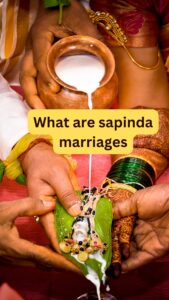Table of Contents
Introduction
Sapinda Marriages the Delhi High Court in the case of Neetu Grover v. Union of India & Ors, 2024 has rejected a challenge to the constitutionality of Section 5(v) of the Hindu Marriage Act, 1955 (HMA), which prohibits marriage between two Hindus if they are “Sapindas” of each other.
What was the case?
In 2007, the marriage of a woman was declared void after her husband proved it was a sapinda marriage and she did not come from a community where such marriages were customary. This decision was challenged in the Delhi High Court, which dismissed the appeal in October 2023.
The woman then petitioned the High Court again, challenging the legality of the sapinda marriage ban. She claimed that sapinda marriages take place even when there is no evidence of custom. As a result, Section 5(v), which prohibits sapinda marriages unless an established custom exists, violates the right to equality guaranteed by Article 14 of the Constitution.
The petitioner also claimed the marriage had received the consent of both families, demonstrating its legitimacy.
Also, Read HINDU MARRIAGE ACT, 1955 PART 1
Sapinda Marriages
A sapinda marriage is one between two people who are related to each other to some extent.
According to Section 3(f)(ii), “Two persons are said to be sapindas of each other if one is a lineal ascendant of the other within the limits of sapinda relationship, or if they have a common lineal ascendant who is within the limits of sapinda relationship regarding each of them.”
According to the HMA, on the mother’s side, a Hindu person cannot marry anyone within three generations of them in the “line of ascent”. On the father’s side, this prohibition applies to anyone within five generations of the individual.
In simple words, this means that on their mother’s side, a person cannot marry their sibling (first generation), parents (second generation), grandparents (third generation), or anyone else who shares this ancestry within the three generations.
Also, Read HINDU MARRIAGE ACT,1955 PART 2
On their father’s side, this prohibition would apply to their grandparents’ grandparents and anyone within five generations of this ancestry.

Why Was the Law Challenged, and What Was the Court’s Ruling?
Petitioner’s Argument
- In 2007, the petitioner’s marriage was declared void after her husband successfully proved that they had entered into a sapinda marriage and that the woman was not from a community where such marriages could be considered a custom.
- The petitioner challenged the constitutional validity of the prohibition on sapinda marriages, arguing that sapinda marriages are prevalent even when there is no proof of custom.
- Hence, Section 5(v) which prohibits sapinda marriages unless there is an established custom, violates the right to equality under Article 14 of the Constitution.
- The petitioner also argued that if the marriage had received the consent of both families, which proved the legitimacy of the marriage.
Delhi Court’s Order
- The Delhi High Court found no merit in her arguments, holding that the petitioner did not provide “stringent proof” of an established custom, which is necessary to justify a sapinda marriage.
- The court held that the choice of a partner in a marriage can be subject to regulation. With this in mind, the court held that the petitioner did not present any “cogent legal ground” to show that the prohibition against sapinda marriages was violative of the right to equality.
What will happen in case of violation?
If a marriage is found to violate Section 5(v) by being a sapinda marriage, and no established custom permits the conduct, it will be declared void.
This would imply that the marriage was invalid from the start and will be treated as if it never took place.
What are the Exceptions to the Prohibitions Against Sapinda Marriages?
The exception is mentioned in Section 5(v) of the Hindu Marriage Act, 1955 and it states that if the customs of the individuals involved permit sapinda marriages, then such marriages would not be declared void. There is an established custom within the community, tribe, group, or family that allows sapinda marriages, and if this custom is continuously and uniformly observed for a long time, it can be considered a valid exception to the prohibition.
“Custom” is provided in Section 3(a) of the HMA, stating that a custom must be continuously and uniformly observed for a long time and should have gained enough legitimacy among Hindus in a local area, tribe, group, or family, such that it has obtained “the force of law.”
However, certain conditions must be met for a custom to be considered valid. The rule in question must be “certain and not unreasonable or opposed to public policy,” and in the case of a rule applicable only to a family, it should not have been “discontinued by the family.”
If these conditions are satisfied, and there is a valid custom permitting sapinda marriages, the marriage would not be declared void under Section 5(v) of the HMA.
